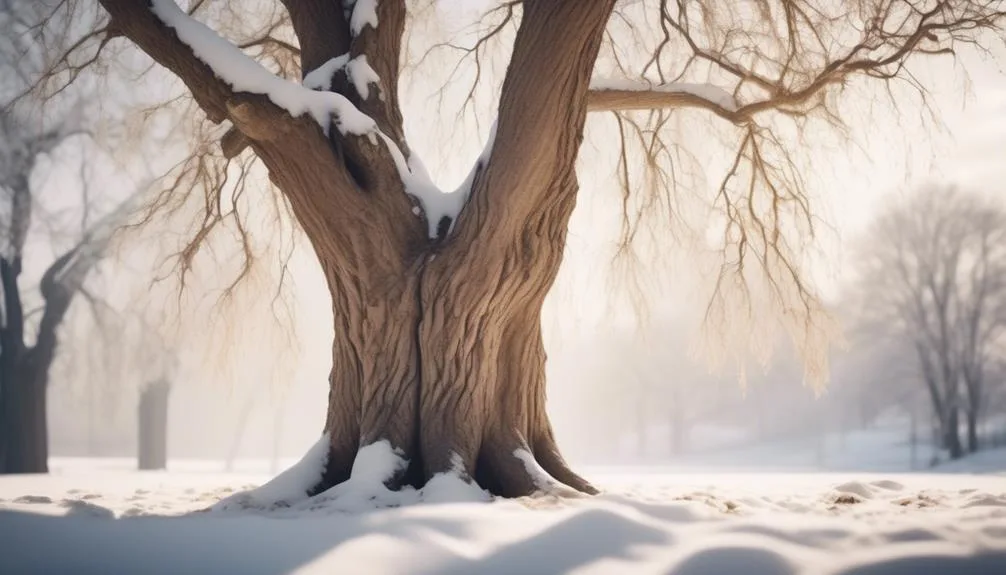Protecting your elm trees from winter burn is essential to their health. As temperatures drop, it's important to take proactive steps. Understanding the symptoms and implementing effective protection measures can shield your trees from damage.
In this article, we'll explore the crucial steps to safeguard your elms through the colder months. With the right knowledge and strategies, you can ensure the health and vitality of your beloved trees.
Winter Burn Symptoms on Elm Trees
If you notice wilting, browning, or scorched leaves on your elm trees during the winter months, it may be a sign of winter burn, a common issue that can affect the health of your trees.
Winter burn occurs when the water in the tree's leaves evaporates faster than the roots can replace it, leading to dehydration and damage.
Identifying tree stressors such as dry or windy conditions, drastic temperature fluctuations, or compacted soil can help prevent winter burn.
To identify winter burn symptoms, examine the foliage for discoloration, browning, and drying out. Additionally, checking the bark for signs of damage and inspecting the overall tree health can help in early detection.
Regular watering, mulching, and protecting the tree from harsh winter conditions can go a long way in preventing winter burn and keeping your elm trees healthy.
Selecting Appropriate Elm Tree Species
Selecting the appropriate elm tree species for your location is crucial for ensuring the health and vitality of your trees. When choosing elm tree varieties, it's important to consider climate considerations such as temperature, humidity, and precipitation. Here are some elm tree species to consider based on climate:
- American Elm (Ulmus americana): This species thrives in a wide range of climates and is particularly well-suited to regions with hot summers and cold winters.
- Lacebark Elm (Ulmus parvifolia): Known for its tolerance to heat, humidity, and drought, making it suitable for regions with warmer climates.
- Siberian Elm (Ulmus pumila): This species is extremely cold hardy and can withstand harsh winter conditions, making it a good choice for colder climates.
Carefully considering elm tree varieties and their compatibility with your local climate can significantly contribute to the long-term health of your trees.
Implementing Winter Protection Measures
When preparing to protect your elm trees from winter burn, consider implementing a combination of preventative measures to safeguard their health during the colder months.
Winter wrapping and insulation techniques are essential for shielding your elm trees from the harsh winter elements. Start by wrapping the trunks of young elm trees with commercial tree wrap or burlap to protect them from sunscald and frost cracks.
Additionally, applying a layer of mulch around the base of the tree can help insulate the soil and roots, preventing temperature fluctuations.
For larger trees, consider using a protective tree guard or building a burlap screen to shield them from drying winter winds.
These winter protection measures will help maintain your elm trees' health and vitality, ensuring they thrive once spring arrives.
Maintaining Moisture and Nutrition Levels
To ensure your elm trees remain healthy throughout the winter, it's crucial to maintain optimal moisture and nutrition levels in the soil and roots, building on the protective measures you've implemented.
Here's how to do it:
- Mulch Application: Apply a 2-4 inch layer of mulch around the base of the tree, extending out to the drip line. This helps retain soil moisture and regulates soil temperature, providing a protective barrier for the roots.
- Watering Schedule: During dry winter periods, ensure to water your elm tree deeply once every 2-4 weeks. Watering should be done when the ground isn't frozen, and the temperature is above 40°F. This helps the tree maintain adequate moisture levels, crucial for its winter survival.
- Nutrient-Rich Soil: Consider adding a slow-release fertilizer to the soil in late fall to ensure the tree has access to essential nutrients throughout the winter.
Monitoring and Adjusting Protection Efforts
As you monitor and adjust your protection efforts for your elm trees during the winter, it's essential to regularly assess the condition of the mulch and soil moisture levels to ensure the continued health and vitality of the trees. Additionally, it's crucial to regularly check temperature fluctuations and adjust insulation as needed. By doing so, you can prevent winter burn and other potential damages caused by extreme cold. Here's a helpful table to guide you in monitoring and adjusting protection efforts for your elm trees:
| Monitoring and Adjustment | Actions |
|---|---|
| Mulch and Soil Moisture | Regularly check and replenish mulch. Monitor soil moisture levels and water as necessary. |
| Temperature Fluctuations | Monitor temperature changes and adjust insulation accordingly. |
Conclusion
In nurturing your elm trees through the winter, you pave the way for their resilience and longevity.
By choosing the right species, implementing protective measures, and maintaining essential care, you're investing in the enduring health of your trees.
Stay vigilant in adjusting your efforts as needed, ensuring your elms thrive and endure the winter season.
With dedicated care, your elm trees can continue to flourish for years to come.

My interest in trees started when I first saw the giant sequoias in Yosemite.
I was a teenager then, and I remember thinking, “I need to learn more about this.”
That moment stuck with me.
A few years later, I went on to study forestry at Michigan Tech.
Since graduating, I’ve worked in a mix of hands-on tree care and community education.
I’ve spent over ten years helping people understand how to plant, maintain, and protect the trees in their neighborhoods.
I don’t see trees as just part of the landscape.
They are living things that make a real difference in our daily lives.
